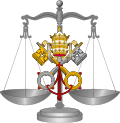 |
| Part of a series on the |
| Canon law of the Catholic Church |
|---|
|
|
Temporalities (bona temporalia, from Latin tempus — "time", plural: Temporalia or Temporalien — „temporal goods“) are the secular properties and possessions of the Catholic Church. The term is most often used to describe those properties (a Stift in German or sticht in Dutch) that were used to support a bishop or other religious person or establishment. Its opposite are spiritualities.[1]
History
[edit]In the Middle Ages, the temporalities were usually those lands that were held by a bishop and used to support him. The distinction between "temporals" and "spirituals" emerged during the Investiture Crisis, as a way to resolve conflicts over ecclesiastical authority. This separation of secular and spiritual responsibilities within church offices was formalized in the Concordat of Worms. According to its conditions, the temporalities of a diocese were granted to the bishop by the secular ruler after the bishop was consecrated.[2]
If a bishop within the Holy Roman Empire had gained secular overlordship to his temporalities imperially recognised as an imperial state, then the temporalities were usually called a Hochstift, or an Erzstift (for an archbishop). Sometimes, this granting of the temporalities could take some time. Other times, a bishop-elect gained his temporalities even before or without his papal confirmation by an imperial act called "liege indult" (Lehnsindult). The temporalities were often confiscated by secular rulers to punish bishops.
Temporalities that involved sovereign or governmental authority were effectively abolished during Germany's secularization. What remained was largely converted into state-funded benefits, with their scope defined by concordats and circumscription bulls.
See also
[edit]References
[edit]- ^ Coredon, Christopher (2007). A Dictionary of Medieval Terms & Phrases (Reprint ed.). Woodbridge: D. S. Brewer. pp. 271–272. ISBN 978-1-84384-138-8.
- ^ Loyn, H. R., ed. (1991). The Middle Ages: A Concise Encyclopedia. London: Thames and Hudson. p. 180. ISBN 0-500-27645-5.